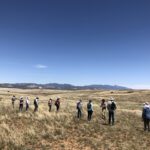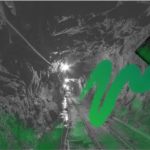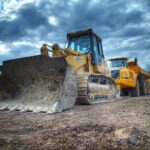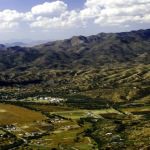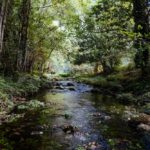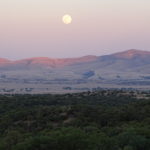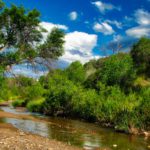
Sep 1, 2016 | Blog
 Release Date: Sep 1, 2016
Release Date: Sep 1, 2016
The Coronado National Forest is designing a system to augment environmental cleanup work previously performed at the Lead Queen Mine on the Sierra Vista Ranger District.
An unusually wet summer monsoon season in 2014 contributed to colored runoff in some drainages in the Patagonia Mountains. This included waters tinted white, yellow, orange and red flowing from the Lead Queen Mine adit, indicating release and oxidation of mineralized waters and sediment.
An environmental cleanup was completed in February, 2016 to reduce or eliminate downstream movement of waste rock containing elevated concentrations of arsenic, lead, and other heavy metals, and to prevent acid mine drainage from entering into Harshaw Creek.
Adits and shafts were closed with polyurethane foam or bat-friendly metal gates. Waste rock was placed in a consolidation cell and capped. Wire gabion baskets were installed downstream of the main adit. Burlap bags filled with zeolite were placed inside the baskets to remove heavy metals and trap sediment particles.
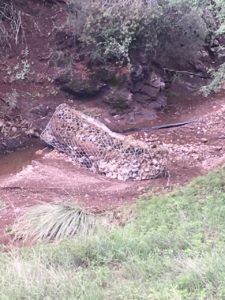 On or about August 9, a short-duration, high-intensity precipitation event on the order of a five- year event (based on National Oceanic and Atmospheric Administration point precipitation frequency estimates, and radar data) passed through the area, resulting in damage to the completed work.
On or about August 9, a short-duration, high-intensity precipitation event on the order of a five- year event (based on National Oceanic and Atmospheric Administration point precipitation frequency estimates, and radar data) passed through the area, resulting in damage to the completed work.
Forest engineering, minerals and geology staff and U.S. Geological Survey scientists inspected and evaluated the damage, and determined a more sustainable and robust system was needed to meet project goals.
Coronado National Forest personnel are assembling a team of U.S. Geological Survey scientists and U.S. Forest Service professionals with expertise in remediation of similar conditions. Once in place, the team will design the improved system and identify a timeline to implement the project.
Further developments will be announced through future news releases.

Oct 26, 2015 | Blog
Environmental Cleanup Actions
The United States Department of Agriculture Forest Service begins this month an environmental cleanup of the Lead Queen Abandoned Mine (Site) situated within the Harshaw Creek watershed. The Site is located approximately six miles south of Patagonia, Arizona, within the Sierra Vista Ranger District of the Coronado National Forest and is only accessed by 4×4 or high clearance vehicles.
The objective of this cleanup is to reduce or eliminate the downstream movement of waste rock containing elevated concentrations of arsenic, lead, and other heavy metals, as well as acid mine drainage to Harshaw Creek.
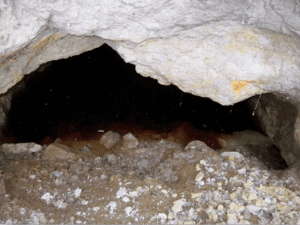
Lead Queen Adit
Past mining activities left behind abandoned horizontal openings (adits) and vertical openings (shafts), and littered the landscape with waste rock material.
The Forest Service hired an environmental firm to perform the cleanup and work should be completed by mid-February 2016. Environmental Cost Management, Inc (ECM) from California was hired for the amount of $361,689.58 of taxpayers’ money to clean up the abandoned mine site on public land.
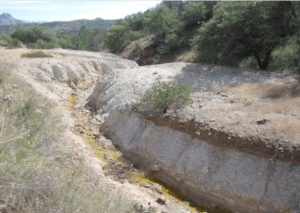
Lead Queen waste rock
The cleanup involves construction activities using heavy equipment to consolidate waste rock into a single underground contained area, cap the waste rock with native soil, and seal 4 of 6 mine openings such as adits and shafts. Polyurethane Foam (PUF) will be used to seal two adits and two shafts. The final PUF face will be covered with clean local soil and rock to prevent UV light degradation of the foam. The other two mine openings will be closed using bat-friendly gates.
In some areas of the Site, adits and shafts serve as conduits carrying large amounts of tunnel water which potentially cause floods in the downstream channels. Storm runoff carries concentrations of heavy metals stored in these adits and shafts on the surface.
Scope of Work
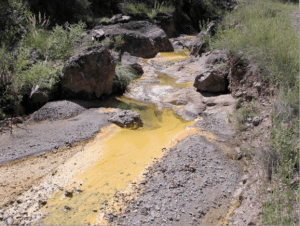
Lead Queen toxic, heavy metal drainage
The Site Cleanup will consist of excavating waste rock, hauling and placing waste rock material in a consolidation area, constructing a series of gabion walls, improving existing road for equipment access, constructing temporary access roads to mines, closing mine features, installing bat- friendly gates, and seeding and mulching of all disturbed areas.
A series of gabion walls will mitigate the transport of aluminum precipitate and red-orange sludge and sediment downstream of the Site and into the lower reaches of the Harshaw Creek watershed. These gabion walls will be installed in the drainage bottom at various locations downstream of the Site.
CERCLA Time Critical Action Removal Action
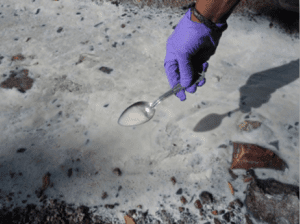
Sampling at Lead Queen mine site
The Forest Service is exercising its authority under the Comprehensive Environmental Response, Compensation, and Liability Act (CERCLA; 42 U.S.C. 9601 et seq.) to conduct the cleanup activities at the Site. The Time Critical Removal Action Approval Memorandum documents and explains the commencement of a CERCLA Removal Action at the Site. The Forest Service’s role is to protect the public health and welfare and the environment and to respond to a hazardous substance release on lands under the jurisdiction of the Forest Service, pursuant to the authority found in 42 U.S.C. 9604(a), Executive Order 12580, and 7 C.F.R. 2.60(a)(39).
Public Information
For additional information about the cleanup, please contact:
Eli Curiel Jr., P.E.,
Project On-Scene Coordinator
USDA Forest Service
Coronado National Forest
300 West Congress Street Tucson, AZ 85701
(520) 388-8413
Monday-Friday, 9:00 AM – 4:30 PM

Related links:
Forest Service Outlines Clean Up Plans for Abandoned Lead Queen Mine https://www.patagoniaalliance.org/forest-service-outlines-clean-up-plans-for-abandoned-lead-queen-mine/
Video: Leaking Historic Patagonia, Arizona Mines https://youtu.be/uEgaFhT5RXw
The U.S. Department of Agriculture (USDA) prohibits discrimination in all its programs and activities on the basis of race, color, national origin, age, disability, and where applicable, sex, marital status, familial status, parental status, religion, sexual orientation, genetic information, political beliefs, reprisal, or because all or part of an individual’s income is derived from any public assistance program. (Not all prohibited bases apply to all programs.) Persons with disabilities who require alternative means for communication of program information (Braille, large print, audiotape, etc.) should contact USDA’s TARGET Center at (202) 720-2600 (voice and TTY). To file a complaint of discrimination, write to USDA, Director, Office of Civil Rights, 1400 Independence Avenue, SW, Washington, DC 20250-9410 or call (800) 795-3272 (voice) or (202) 720-6382 (TTY). USDA is an equal opportunity provider and employer.
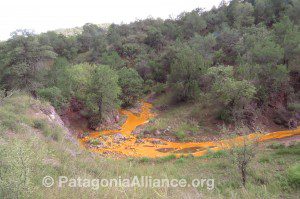
May 8, 2015 | Blog

Toxic overflow from the historic Lead Queen mine in the Patagonia Mountains drains towards Harshaw Creek.
The Coronado National Forest, Sierra Vista Ranger District hosted a community meeting in Patagonia, Arizona on April 28. The Lead Queen Mine cleanup plan was by presented by Floyd Gray of United States Geological Survey (USGS), and Eli Curiel of the Forest Service.
The Lead Queen was an underground mine for lead, silver, zinc, copper and gold that started in 1898 and was abandoned after 1940. After heavy rains in September 2014, members of PARA discovered and reported the leaking mine site, located approximately 6 miles south of Patagonia, Arizona. In December, the Arizona Department of Environmental Quality served the Forest Service with two notices of violation for the toxic mine spill. The Forest Service issued a “Time Critical Removal Action Approval Memorandum” in February to mitigate the spill and its potential threats to public health and welfare, water and wildlife. Clean up was scheduled to start Spring 2015, before monsoon rains could potentially wash contamination further downstream.
Floyd Gray gave an overview of his findings from sampling and testing the water, soil, and waste rock around the abandoned mine site. It was also deduced that there is more than one source of leakage from the mine site. One source was identified by its extreme concentration of iron while the other source is high in aluminum. All of the tested samples came back with very high levels of contamination from hazardous heavy metals such as arsenic and lead. In one water sample, the heavy metal levels were 20 times higher than the allowable drinking water standards. It was also determined that the mine contamination traveled 9/10th of a mile downstream.
The studies at the Lead Queen site to determine all of the sources of contamination has lead to a larger, ongoing study of the watersheds in the Patagonia Mountains by USGS and the Forest Service.
Eli Curiel detailed the plans to plug the six abandoned tunnels and shafts of the Lead Queen mine site with polyurethane foam. The waste rock piles laced with toxic heavy metals will be consolidated into a new location above the watershed and capped with clean fill to prevent future contamination. The polluted sediment in the waterway will be removed with the aid of a series of eleven gabion walls across the drainage filled with zeolite to capture and hold the heavy metals. The clean up area comprises five acres on the Coronado National Forest in the Patagonia Mountains. The mine site will require ongoing monitoring and maintenance, essentially forever.
The cost to taxpayers has not yet been determined. The clean up project has not yet gone out to bid. It’s expected to take up to 120 days with work possibly starting this summer.
More information can be obtained from the Forest Service Project On-Scene Coordinator, Eli Curiel at 520-388-8413.
Regal Resources Sunnyside Mine Exploration
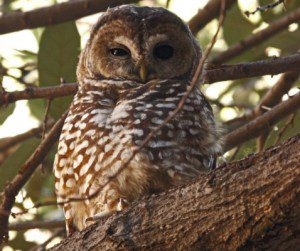
Mexican Spotted Owl ©Gooch Goodwin
At the public meeting, an update was given on Regal Resources’ Sunnyside mining exploration project in the Patagonia Mountains by Forest Service Geologist Mindy Vogel. Conspicuously absent from Vogel’s overview was the ongoing litigation between Defenders of Wildlife and PARA against the Forest Service and US Fish and Wildlife for the unlawful approval of this project.
For the present time, no work is allowed at the Sunnyside site between March 1 and Oct 1, 2015 because of nesting Mexican spotted owls and Yellow-billed cuckoos in the area, according to the Forest Service Decision Memo.
No questions were permitted during any of the presentations. Audience members were required to seek out Forest Service and USGS personnel after all presentations were complete to ask questions. It is a format that we find effectively prevents members of the community from getting all of their questions answered and learning the most information possible.
Wildcat Silver Hermosa Proposal
Forest Service geologist Margie DeRose gave an overview and an update of the expected timeline of the AZ Mining Inc (aka Wildcat Silver, AMI) Hermosa mining exploration proposal in the Patagonia Mountains on the Coronado National Forest. The final Environmental Assessment and draft decision is estimated for release in October 2015 – over a year past the original timeline. A 45 day public objection period will follow.
Meanwhile, AZ Mining Inc / Wildcat Silver board chairman Richard Warke is privately funding more mine exploration drilling on their privately owned land. AZ Mining Inc / Wildcat Silver is now claiming that deposits for lead, zinc and silver exist for an additional mine at the Hermosa project, referred to as Hermosa North West.

 Release Date: Sep 1, 2016
Release Date: Sep 1, 2016 On or about August 9, a short-duration, high-intensity precipitation event on the order of a five- year event (based on National Oceanic and Atmospheric Administration point precipitation frequency estimates, and radar data) passed through the area, resulting in damage to the completed work.
On or about August 9, a short-duration, high-intensity precipitation event on the order of a five- year event (based on National Oceanic and Atmospheric Administration point precipitation frequency estimates, and radar data) passed through the area, resulting in damage to the completed work.








